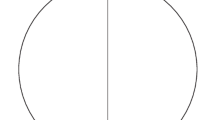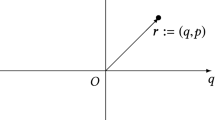Abstract
I propose a version of quantum mechanics featuring a discrete and finite number of states that is plausibly a model of the real world. The model is based on standard unitary quantum theory of a closed system with a finite-dimensional Hilbert space. Given certain simple conditions on the spectrum of the Hamiltonian, Schrödinger evolution is periodic, and it is straightforward to replace continuous time with a discrete version, with the result that the system only visits a discrete and finite set of state vectors. The biggest challenges to the viability of such a model come from cosmological considerations. The theory may have implications for questions of mathematical realism and finitism.

Similar content being viewed by others
Notes
Discussions of fundamental theories often revolve around approaches to unification and quantum gravity, such as superstring theory. But for the most part all of these approaches live within the standard framework of quantum mechanics; they are specific models under that broad umbrella, rather than alternatives to it.
References
Easwaran, K., Hájek, A., Mancosu, P., Oppy, G.: Infinity. In: Zalta, E.N. (ed.) The Stanford Encyclopedia of Philosophy. Metaphysics Research Lab, Stanford University, Winter (2021)
Wolfram, S.: A class of models with the potential to represent fundamental physics. Complex Syst. 29(2), 107–536 (2020). arXiv:2004.08210 [cs.DM]
Maldacena, J.M.: The Large N limit of superconformal field theories and supergravity. Int. J. Theor. Phys. 38, 1113–1133 (1999). arXiv:9711200 [hep-th]
Surya, S.: The causal set approach to quantum gravity. Living Rev. Relativ. 1, 22 (2019)
Buniy, R., Hsu, S., Zee, A.: Is Hilbert space discrete? Phys. Lett. B630, 68–72 (2005). arXiv:0508039 [hep-th]
Palmer, T.N.: Discretised hilbert space and superdeterminism. arXiv:2204.05763 [quant-ph]
Bao, N., Carroll, S.M., Singh, A.: The Hilbert space of quantum gravity is locally finite-dimensional. Int. J. Mod. Phys. D 26(12), 1743013 (2017). arXiv:1704.00066
Carroll, S.M., Singh, A.: Mad-dog Everettianism: quantum mechanics at its most minimal. In: Aguirre, A., Foster, B., Merali, Z. (eds.) What is Fundamental?, pp. 95–104. Springer, New York (2019) . arXiv:1801.08132 [quant-ph]
Carroll, S.M.: Reality as a vector in Hilbert space. arXiv:2103.09780 [quant-ph]
Wallace, D.: The Emergent Multiverse: Quantum Theory According to the Everett Interpretation. Oxford University Press, Oxford (2012)
Albert, D.: Elementary quantum metaphysics. In: Cushing, J.T., Fine, A., Goldstein, S. (eds.) Bohmian Mechanics and Quantum theory: An Appraisal, pp. 277–284. Kluwer Academic Publishers, Norwell (1996)
Carroll, S.M., Singh, A.: Quantum mereology: factorizing Hilbert space into subsystems with quasiclassical dynamics. Phys. Rev. A 103(2), 022213 (2021). arXiv:2005.12938 [quant-ph]
Cotler, J.S., Penington, G.R., Ranard, D.H.: Locality from the spectrum. Commun. Math. Phys. 368(3), 1267–1296 (2019). arXiv:1702.06142 [quant-ph]
Cao, C., Carroll, S.M., Michalakis, S.: Space from Hilbert space: recovering geometry from bulk entanglement. Phys. Rev. D 95(2), 024031 (2017). arXiv:1606.08444 [hep-th]
Cao, C., Carroll, S.M.: Bulk entanglement gravity without a boundary: towards finding Einstein’s equation in Hilbert space. Phys. Rev. D 97(8), 086003 (2018). arXiv:1712.02803 [hep-th]
Levin, M.A., Wen, X.-G.: String net condensation: a physical mechanism for topological phases. Phys. Rev. B 71, 045110 (2005). arXiv:0404617 [cond-mat]
Carroll, S.M., Chatwin-Davies, A.: Cosmic equilibration: a holographic no-hair theorem from the generalized second law. arXiv:1703.09241 [hep-th]
Banks, T.: Cosmological breaking of supersymmetry? Int. J. Mod. Phys. A 16, 910–921 (2001). arXiv:0007146 [hep-th]
Nomura, Y.: Physical theories, eternal inflation, and quantum universe. JHEP 11, 063 (2011). arXiv:1104.2324 [hep-th]
Bousso, R., Susskind, L.: The multiverse interpretation of quantum mechanics. Phys. Rev. D 85, 045007 (2012). arXiv:1105.3796 [hep-th]
Bao, N., Cao, C., Carroll, S.M., McAllister, L.: Quantum circuit cosmology: the expansion of the universe since the first qubit. arXiv:1702.06959 [hep-th]
Dyson, L., Kleban, M., Susskind, L.: Disturbing implications of a cosmological constant. JHEP 10, 011 (2002). arXiv:0208013 [hep-th]
Albrecht, A., Sorbo, L.: Can the universe afford inflation? Phys. Rev. D 70(6), 063528 (2004)
Carroll, S.M.: What if time really exists?. arXiv:0811.3772 [gr-qc]
Carroll, S.M.: Why Boltzmann brains are bad. In: Dasgupta, S., Dotan, R., Weslake, B. (eds.) Current Controversies in Philosophy of Science, pp. 7–20. Routledge, Milton Park (2017)
Boddy, K.K., Carroll, S.M., Pollack, J.: De sitter space without dynamical quantum fluctuations. Found. Phys. 46(6), 702–735 (2016)
Lloyd, S.: Decoherent histories approach to the cosmological measure problem. arXiv:1608.05672 [quant-ph]
Page, D.N., Wootters, W.K.: Evolution without evolution: dynamics described by stationary observables. Phys. Rev. D 27, 2885 (1983)
Banks, T.: T C P, quantum gravity, the cosmological constant and all that. Nucl. Phys. B 249, 332–360 (1985)
Albrecht, A., Iglesias, A.: The clock ambiguity and the emergence of physical laws. Phys. Rev. D 77, 063506 (2008). arXiv:0708.2743 [hep-th]
Rovelli, C.: Forget time. Found. Phys. 41, 1475–1490 (2011). arXiv:0903.3832 [gr-qc]
Giovannetti, V., Lloyd, S., Maccone, L.: Quantum time. Phys. Rev. D 92(4), 045033 (2015). arXiv:1504.04215 [quant-ph]
Marletto, C., Vedral, V.: Evolution without evolution and without ambiguities. Phys. Rev. D 95(4), 043510 (2017). arXiv:1610.04773 [quant-ph]
Singh, A.: Quantum space, quantum time, and relativistic quantum mechanics. Quant. Stud. Math. Found. 9(1), 35–53 (2022). arXiv:2004.09139 [quant-ph]
Putnam, H.: What is mathematical truth? Hist. Math. 2(4), 529–533 (1975)
Carroll, S.M.: Reality realism. https://philarchive.org/rec/CARRRK
Presburger, M.: Uber die vollstandigkeiteines gewissen systems der arithmetik ganzer zahlen, in welchen die addition als einzige operation hervortritt. In: Comptes-Rendus du ler Congres des Mathematiciens des Pays Slavs. (1929)
Haase, C.: A survival guide to Presburger arithmetic. ACM SIGLOG News 5(3), 67–82 (2018). https://doi.org/10.1145/3242953.3242964
Ye, F.: Strict Finitism and the Logic of Mathematical Applications, vol. 355. Springer, New York (2011)
Acknowledgements
It is a pleasure to thank Justin Clarke-Doane for helpful comments.
Author information
Authors and Affiliations
Contributions
All contributions were made by the single author
Corresponding author
Ethics declarations
Competing interest
The authors declare no competing interests
Additional information
Publisher's Note
Springer Nature remains neutral with regard to jurisdictional claims in published maps and institutional affiliations.
Rights and permissions
Springer Nature or its licensor (e.g. a society or other partner) holds exclusive rights to this article under a publishing agreement with the author(s) or other rightsholder(s); author self-archiving of the accepted manuscript version of this article is solely governed by the terms of such publishing agreement and applicable law.
About this article
Cite this article
Carroll, S.M. Completely Discretized, Finite Quantum Mechanics. Found Phys 53, 90 (2023). https://doi.org/10.1007/s10701-023-00726-6
Received:
Accepted:
Published:
DOI: https://doi.org/10.1007/s10701-023-00726-6




